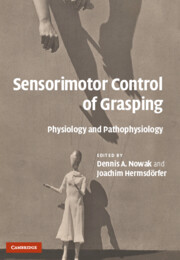Book contents
- Frontmatter
- Contents
- List of contributors
- Preface
- Part I Methodology
- 1 Analysis of grip forces during object manipulation
- 2 Kinematic assessment of grasping
- 3 Digit forces in multi-digit grasps
- 4 Recordings from the motor cortex during skilled grasping
- 5 Recording of electromyogram activity in the monkey during skilled grasping
- 6 Transcranial magnetic stimulation investigations of reaching and grasping movements
- 7 Neuroimaging of grasping
- 8 Functional magnetic resonance imaging studies of the basal ganglia and precision grip
- 9 Models for the control of grasping
- Part II The physiology of grasping
- Part III The pathophysiology of grasping
- Part IV Therapy of impaired grasping
- Index
- Plate section
- References
8 - Functional magnetic resonance imaging studies of the basal ganglia and precision grip
Published online by Cambridge University Press: 23 December 2009
- Frontmatter
- Contents
- List of contributors
- Preface
- Part I Methodology
- 1 Analysis of grip forces during object manipulation
- 2 Kinematic assessment of grasping
- 3 Digit forces in multi-digit grasps
- 4 Recordings from the motor cortex during skilled grasping
- 5 Recording of electromyogram activity in the monkey during skilled grasping
- 6 Transcranial magnetic stimulation investigations of reaching and grasping movements
- 7 Neuroimaging of grasping
- 8 Functional magnetic resonance imaging studies of the basal ganglia and precision grip
- 9 Models for the control of grasping
- Part II The physiology of grasping
- Part III The pathophysiology of grasping
- Part IV Therapy of impaired grasping
- Index
- Plate section
- References
Summary
Summary
Grasping behavior has been well studied in both human and non-human primates. Studies have revealed a classic grasping circuit that involves several regions, such as the motor, prefrontal and parietal cortices. However, the functional contribution of the basal ganglia to grasping control is often overlooked. This is surprising because many basal ganglia disorders (e.g. Parkinson's disease) have been experimentally associated with deficits in grasping control. Recent work in our laboratory used fMRI to demonstrate that the caudate, putamen, internal and external segments of the globus pallidus (GPi and GPe, respectively), and subthalamic nucleus (STN) participate in circuits that independently regulate the selection and scaling of parameters important for grasping. These findings provide new evidence that grasping must be considered as a behavior that is processed in both cortical and subcortical structures.
Introduction
Prehension remains one of the most important functions of primate motor systems. The remarkable adaptability and effortlessness with which primates can reach for and grasp objects of variable size, shape and mass has had unequivocal evolutionary importance. Nevertheless, it is widely accepted that even simple reach-to-grasp movements pose considerable challenges for the primate sensorimotor system (Johnson-Frey, 2003). During the prehension of a given object, individuals must use visual (i.e. object distance, direction) and somatosensory information (i.e. joint angle) to transport the hand to the object location via a precisely aimed reaching movement.
Information
- Type
- Chapter
- Information
- Sensorimotor Control of GraspingPhysiology and Pathophysiology, pp. 99 - 109Publisher: Cambridge University PressPrint publication year: 2009
